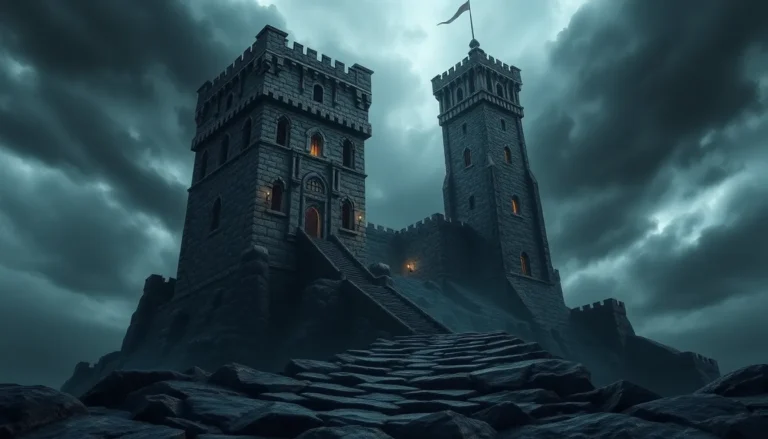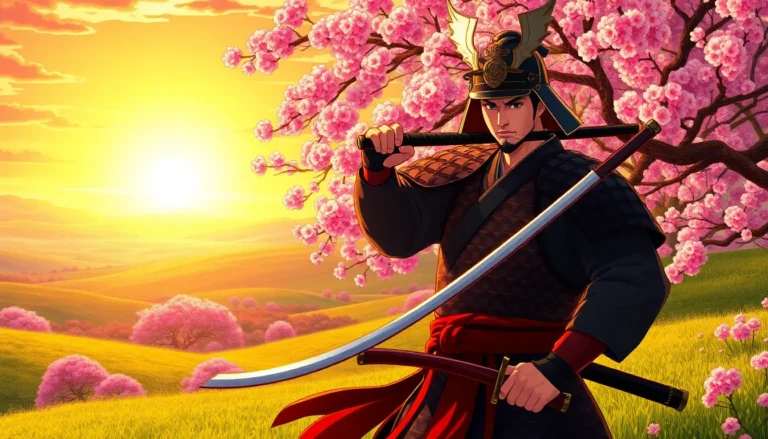Table of Contents
ToggleIn the world of gaming, few combinations spark intrigue like Bloodborne armor and Ghost of Tsushima. Imagine donning the eerie, gothic aesthetics of Bloodborne while galloping through the stunning landscapes of Tsushima. It’s like mixing sushi with a side of blood pudding—unexpected but oh-so-delicious!
Gamers often seek the ultimate gear to elevate their experience, and merging these two iconic titles offers a thrilling twist. Whether you’re slashing through Mongol invaders or dodging nightmarish creatures, the right armor can make all the difference. Dive into this unique fusion and discover how to blend the best of both worlds, making your gameplay not just effective but also fabulously stylish. Who knew looking this good while battling could be so much fun?
Overview of Bloodborne Armor in Ghost of Tsushima
Bloodborne armor offers a unique blend of style and utility in Ghost of Tsushima. Players can appreciate how gothic designs transform the visual experience within the game’s stunning environments. The armor features intricate details and dark aesthetics, providing a stark contrast to the vibrant landscapes of Tsushima.
In terms of gameplay, this armor enhances combat effectiveness. Each piece contributes specific bonuses, allowing players to adapt their strategies when facing various enemy types. Wearers of Bloodborne armor may gain advantages such as increased stealth or improved damage resistance.
Acquiring this armor involves specific tasks and objectives. Players often seek out unique challenges that echo the gameplay mechanics present in Bloodborne. Completing these tasks rewards gamers with gear that reflects the core themes of both titles.
Customization options further enrich the experience. Dressing Jin in Bloodborne armor allows for experimentation with different styles and attributes. Throughout the game, players can mix and match armor sets to create a personalized combat experience.
The visual appeal of Bloodborne armor captivates many players. Eye-catching designs evoke a sense of nostalgia for those familiar with FromSoftware’s title. Exploring the world of Tsushima while donning this armor adds layers to the overall narrative experience.
Together, these elements showcase how Bloodborne armor integrates into Ghost of Tsushima. This combination enhances both gameplay dynamics and aesthetic enjoyment, merging two iconic gaming worlds seamlessly.
Features of Bloodborne Armor
Bloodborne armor in Ghost of Tsushima possesses distinct features that enhance both gameplay and aesthetic appeal. Its design draws heavily from gothic architecture, creating a stark contrast against Tsushima’s serene landscapes.
Appearance and Design
Intricate patterns and dark textures define the appearance of Bloodborne armor. Players notice detailed engravings that reflect the haunting atmosphere of the original game. This armor’s silhouette also stands out, showcasing fluid lines and armor plates that mimic a samurai’s elegance while embodying the chilling essence of Bloodborne. A blend of dark tones and subtle highlights give the armor a striking visual presence, making it appealing to players. Various customization options further enhance individual style, allowing players to express their unique identity while exploring the rich world of Tsushima.
Stat Enhancements
Bloodborne armor provides significant stat enhancements that cater to different combat strategies. Players enjoy boosted stamina regeneration when wearing certain pieces, improving agility during intense battles. Additionally, some armor sets increase resistance to specific damage types, making encounters with diverse enemies more manageable. Enhanced critical hit chances also allow for devastating attacks, transforming the gameplay experience. These bonuses encourage players to adapt their approach to combat, maximizing effectiveness while tackling challenging scenarios throughout the game.
How to Obtain Bloodborne Armor
Acquiring Bloodborne armor in Ghost of Tsushima involves meeting specific requirements and completing challenges designed to reflect the original game’s intensity.
Requirements and Challenges
Players must complete a set of challenges to obtain Bloodborne armor. These often require defeating particular enemies, showcasing specific combat skills, or exploring particular areas. Each challenge tests various mechanics from both games, allowing for a seamless blend of experiences. The challenges not only build on combat efficiency but also enhance player mastery. Completing these tasks rewards players with pieces of the Bloodborne gear that provide valuable bonuses. Such gear significantly increases a player’s effectiveness in combat scenarios.
Locations and Quests
Key locations for obtaining Bloodborne armor include hidden shrines and challenging quest areas across Tsushima. Players must search meticulously to find these quests, often located in less-traveled regions, like mountainous terrains or shadowy forests. These quests typically feature compelling story elements that draw from both game’s lore. Completing them leads to epic battles against formidable foes, crucial for unlocking the armor’s full potential. Engaging with NPCs can offer additional hints on these hidden locales, offering a rewarding journey towards the coveted Bloodborne armor.
Advantages of Using Bloodborne Armor
Bloodborne armor significantly enhances gameplay in Ghost of Tsushima. Players benefit from increased stamina regeneration, enabling faster and more fluid movement during combat. A notable feature includes heightened resistance to specific damage types, allowing for tailored defensive strategies against different enemy types.
Enhanced critical hit chances provide another layer of advantage. Gamers can adapt their combat approaches, encouraging them to take calculated risks during encounters. Unique aesthetic designs also play a crucial role, merging gothic elements with the game’s vibrant landscapes, which not only captivates visually but also adds an immersive layer to the experience.
Acquiring Bloodborne armor involves engaging challenges. Completing quests and defeating formidable foes rewards players with gear that embodies the fusion of both worlds. Locations to find the armor include hidden shrines, often in less-traveled areas of Tsushima, making the quest engaging and rewarding.
Customization options further enhance the experience. Players can modify the armor’s appearance to reflect their unique identity, adding a personal touch to their journey. This combination of visual appeal and functional benefits makes Bloodborne armor a desirable choice for players looking to elevate their gameplay.
Interacting with non-playable characters provides hints about hidden locations. These interactions not only add depth to the narrative but also guide players in their quest for powerful gear. Altogether, Bloodborne armor integrates seamlessly into Ghost of Tsushima, reinforcing both combat effectiveness and aesthetic enjoyment.
Comparisons with Other Armors in the Game
Bloodborne armor distinguishes itself within Ghost of Tsushima, offering a unique blend of aesthetics and functionality. It contrasts sharply with traditional samurai armor, typically centered on mobility and defense. The gothic architectural design of Bloodborne armor enhances its appeal, presenting a haunting elegance not seen in other gear types.
Moreover, the gameplay benefits from the armor’s stat enhancements. Boosted stamina regeneration allows for increased agility, setting it apart from heavier armors that sacrifice mobility for protection. Critical hit bonuses prove advantageous against more challenging enemies, providing players with tactical advantages during intense combat scenarios.
While common armors may grant basic protection, Bloodborne armor consists of specific bonuses catering to diverse playstyles. Players seeking offensive strategies benefit from increased damage output, while those focused on stealth gain improved resistance mechanics. This contrast encourages players to experiment with different combat approaches, fostering a dynamic game experience.
Notably, acquiring Bloodborne armor requires players to complete unique quests and defeat formidable enemies. Other armors may involve straightforward collection or crafting quests, but obtaining this specific armor entails engaging in challenging combat scenarios. The journey often unearths hidden shrines and intriguing storylines, deepening players’ immersion in the expansive world of Tsushima.
Lastly, customization options available for Bloodborne armor allow for individual expression. Other armors might offer few aesthetic variations, but players can modify Bloodborne armor to create a personalized look that reflects their unique style. This combination of visual allure and practical benefits solidifies Bloodborne armor as a striking addition among the wide array of armor choices in Ghost of Tsushima.
Conclusion
The fusion of Bloodborne armor with Ghost of Tsushima creates a captivating experience for players. It seamlessly combines gothic aesthetics with the stunning landscapes of Tsushima while enhancing gameplay through unique bonuses. This armor not only elevates combat effectiveness but also allows for personal expression through customization.
As players embark on quests to acquire this striking gear, they engage with the rich narrative and challenges that both games offer. The distinctive features of Bloodborne armor set it apart, encouraging diverse combat strategies and adding depth to the overall gaming experience. Embracing this blend of styles invites players to explore new dimensions in their adventures, making it a standout choice for those looking to enrich their journey in Ghost of Tsushima.






